| Pictures of the tooth in its gold-acorn case taken by Jean Marie Pegrin Starr. |
L. David Roper (roperld@vt.edu)
(www.roperld.com)
Human nuclear DNA consist of 23 chromosome pairs. One chromosome in each pair comes from the father and one comes from the mother. Before 23 (22 for males) of the pairs separate to form the single 23 (22 for males) chromosomes in the female egg or the male sperm, the two chromosomes in each pair exchange genes randomly, so that the single chromosome in the egg or sperm is different for each child produced, except for identical twins. This is called recombination. There is one exception to recombination: the XY-chromosome pair for a male does not recombine for most of the length of the chromosome. So when the male XY-chromosome pair separates to form sperm, some sperms have essentially the same X-chromosome as the male had and some sperms have essentially the same Y-chromosome as the male had. However, the XX-chromosome pair for a female does recombine when it separates. If an X-sperm fertilizes an egg, a female child is produced or if a Y-sperm fertilizes an egg, a male child is produced. Therefore, the male child carries essentially the same Y-chromosome as his father. However, a female child carries the same X-chromosome as her father but a different X-chromosome than her mother had; she passes on to her progeny a different X-chromosome than either her father or mother had.
Thus, the X-chromosome gets changed by recombination each generation but the Y-chromosome remains essentially the same as it is passed on. This enables use of the Y-chromosome to determine male-line ancestry. (There is a way to determine female-line ancestry through mitochondria DNA, but it is not nearly as helpful in genealogy as is the Y-chromosome.)
If Benjamin Franklin's 23 chromosome pairs were available one could sequence them and have the ultimate artifact related to him. Even if his 23 chromosome pairs are not available, one might be able to get some information about his Y-chromosome, since it is passed down male lines essentially unchanged. Unfortunately, there is no documentary evidence that he has living strictly male-line descendants. However, he had many brothers and uncles, who would have had essentially the same Y-chromosome as Benjamin had. If one, but preferably more than one, of the descendants of his brothers or uncles could be located, much could be learned about Benjamin's Y-chromosome. One could completely sequence such a Y-chromosome. However, some small amount of recombination with the X-chromosome does occur on the ends of the male XY-chromosome pair; so the result would not be exactly the same as it would have been for Benjamin's Y-chromosome.
There are "junk" regions on the Y-chromosome that contain repeated base-pair sets (microsatellites or Short Tandem Repeats or STR). Over time the number of repeats changes due to mutations; these mutations have no effect on the health of the person. The number of repeats at these locations, called “markers” can be used to distinguish different male-line families. Thus, the detailed structure in terms of base-pair coding is not required; only information about certain aspects of a small part of the Y-chromosome is needed. This does not identify the individual, but only the family to which the individual belongs; determining 12, 25 or 37 markers (see below) is much less information than that obtained by totally sequencing the Y-chromosome. There are several labs that do such markers determinations, at a cost of about $100 per person for 12 markers.
A company in Houston, Texas, Family Tree DNA (http://www.familytreedna.com), with the help of a genetics laboratory at University of Arizona, can measure 12, 25 or 37 markers of a Y-chromosome. Thus, one might be able to determine markers for Benjamin's Y-chromosome; then any other male could have his markers measured and compare them to Benjamin's to see if he is related to Benjamin. (There are rare random mutations that occur with a rate of about one every 500 generations for each marker; these random mutations can be used to differentiate different branches of a family.) Benjamin was an excellent genealogist and scientist; I am convinced that, if he were here, he would be very excited about this use of Y-chromosomes to determine relationships and ancestry.
For detailed information about the Y-chromosome markers see: http://freepages.genealogy.rootsweb.com/~dgarvey/DNA/RelGen/definitons.html. One further point: The markers occur in "junk" portions of the Y-chromosome; that is, portions that have no effect on inheritance. (It is estimated that 97% of DNA is "junk", which possibly had an effect on inheritance in the far distant past, but no more. Think of it as files in your computer that are of no more use to you, but you have forgotten about them and have never bothered to delete them.) The mutations that occur on "junk" DNA get propagated down generations because there is no selection for or against them. They are very useful for distinguishing different branches of a family.
We know where Benjamin is buried. I have no doubt in my mind that, if he could advise us about obtaining his DNA, he would say one word: "Exhume!"; he was a scientist to the core who would want to know all that is possible about his DNA. However, even if the authorities in charge of his burial site would allow his exhumation, the DNA might be so degraded that very little information could be obtained. But some DNA from even older bodies than his has been analyzed; there are ways now to patch together bits of DNA. If he still had a solid tooth when he died, that would probably be the most likely place to find some relatively intact DNA. (A hair does not work for male lines unless it contains its follicle or some attached skin cells. See: http://www.promega.com/profiles/502/ProfilesInDNA_502_11.pdf)
Perhaps some enterprising dentist once pulled out a tooth of this famous man, Benjamin Franklin, and decided to keep it as a valuable artifact related to Benjamin. Perhaps the dentist authenticated it with a document. And perhaps he sold or gave the tooth and documentation to someone. And perhaps someone still has the tooth and documentation. Given all of these possibilities, how would one go about finding such a tooth and documentation? It has been suggested that advertisements in dental journals in the USA, Great Britain and France might yield such a tooth. This should definitely be tried, although the odds of success are probably about the same as winning a multi-state lottery.
The most likely way to obtain some information about Benjamin's DNA is to measure the Y-chromosome markers of one of his male-line Franklin relatives. For information about a project to do this see: Franklin Families Genetics Project.
The United States Congress established the Benjamin Franklin Tercentenary Commission, one of whose duties is to do: "The acquisition and preservation of artifacts associated with Benjamin Franklin." Information about Benjamin Franklin's DNA would be the ultimate artifact associated with him.
Human mitochondria (the energy-producing organelles outside the nucleus of cells) DNA is passed down generations only through females. Thus, testing of the DNA in mitochondria can aid in establishing matrilineal lines, but it requires almost a complete sequencing of mtDNA. (Establishing matrilineal lines with documents is more difficult than for patrilineal lines in most European lines because the surnames of females are lost in naming children; exceptions are Spanish and Portuguese.)
mtDNA is a circular structure composed of 16,569 nucleotides, also called base pairs (about 20 genes). (It is believed that the mitochondrion originally was a parasitic bacterium which, through evolution, became symbiotic with the human cell and then became an integral part of the cell; bacterium DNA is circular.) There is a section of the mtDNA that is used to differentiate different groups of matrilineal lines by the different mutations that occur. There are two tests that are done on this section, a low resolution test called HVR1 and a high resolution test called HVR2.
Getting Benjamin Franklin's mtDNA may be easier than getting his Y-chromosome, because all female-line descendants of his mother's six sisters (Folgers/Foulgers) and of his four full sisters carry his mtDNA. The Folger genealogy is well developed. His mother is Abiah Lee Folger.. (Note that Benjamin Franklin inherited his mtDNA from his mother, but did not pass it on to his descendants. Only his mother could pass it on.)
One such purported female-line descendant, Charlene Chambers King, of Abiah's sister Dorcas has had her mtDNA HVR1 and HVF2 measured. The result is available at http://freepages.family.rootsweb.com/~crrking/mills/mills_dnam.htm. It is in the mtDNA hapolgroup V (Velda) with relative mutations from the Cambridge Reference Sequence at location 16298 for the HVR1 sequence (change of a T nucleotide to a C nucleotide) and mutations at locations 72 (change of a T nucleotide to a C nucleotide), 263 (change of an A nucleotide to a G nucleotide), 309.1C and 315.1C for the HVR2 sequence. (The .1C indicates that an extra C is inserted after the 309 and 315 locations.) Velda is one of the "The Seven Daughters of Eve", the one that originated in northern Spain c17,000 years ago. About 5% of Europeans descend from Velda.
| mtDNA HVR1 results for Charlene Chambers King; mutations are indicated in red below the CRS values. (Starts at 16001.) | ||||||||||
| Cambridge Reference Sequence HVR1: | ||||||||||
| 10 | 20 | 30 | 40 | 50 | 60 | 70 | 80 | 90 | 100 | |
| ATTCTAATTT | AAACTATTCT | CTGTTCTTTC | ATGGGGAAGC | AGATTTGGGT | ACCACCCAAG | TATTGACTCA | CCCATCAACA | ACCGCTATGT | ATTTCGTACA | 0 |
| TTACTGCCAG | CCACCATGAA | TATTGTACGG | TACCATAAAT | ACTTGACCAC | CTGTAGTACA | TAAAAACCCA | ATCCACATCA | AAACCCCCTC | CCCATGCTTA | 1 |
| CAAGCAAGTA | CAGCAATCAA | CCCTCAACTA | TCACACATCA | ACTGCAACTC | CAAAGCCACC | CCTCACCCAC | TAGGATACCA | ACAAACCTAC | CCACCCTTAA CCACCCTCAA |
2 |
| CAGTACATAG | TACATAAAGC | CATTTACCGT | ACATAGCACA | TTACAGTCAA | ATCCCTTCTC | GTCCCCATGG | ATGACCCCCC | TCAGATAGGG | GTCCCTTGAC | 3 |
| mtDNA HVR2 results for Charlene Chambers King; mutations are indicated in red below the CRS values. (Starts at 61.) | |||||||||||
| 10 | 20 | 30 | 40 | 50 | 60 | 70 | 80 | 90 | 100 | ||
| Add | CGTCTGGGGG | GTATGCACGC GCATGCACGC |
GATAGCATTG | CGAGACGCTG | Add | ||||||
| +100ll | GAGCCGGAGC | ACCCTATGTC | GCAGTATCTG | TCTTTGATTC | CTGCCTCATC | CTATTATTTA | TCGCACCTAC | GTTCAATATT | ACAGGCGAAC | ATACTTACTA | +100 |
| +200 | AAGTGTGTTA | ATTAATTAAT | GCTTGTAGGA | CATAATAATA | ACAATTGAAT | GTCTGCACAG | CCACTTTCCA CCGCTTTCCA |
CACAGACATC | ATAACAAAAA | ATTTCCACCA | +200 |
| +300 | AACCCCCCCT AACCCCCCCCT |
CCCCCGCTTC CCCCCCGCTTC |
TGGCCACAGC | ACTTAAACAC | ATCTCTGCCA | AACCCCAAAA | ACAAAGAACC | CTAACACCAG | CCTAACCAGA | TTTCAAATTT | +300 |
| +400 | TATCTTTTGG | CGGTATGCAC | TTTTAACAGT | CACCCCCCAA | CTAACACATT | ATTTTCCCCT | CCCACTCCCA | TACTACTAAT | CTCATCAATA | CAACCCCCGC | +400 |
| +500 | CCATCCTACC | CAGCACACAC | ACACCGCTGC | TAACCCCATA | CCCCGAACCA | ACCAAACCCC | AAAGACACCC | +500 | |||
To be sure that Charlene Chambers King's mtDNA is Benjamin Franklin's mtDNA, some other female in another female line back to a full sister of Benjamin or a Folger aunt of Benjamin needs to have her mtDNA measured to see if it is the same as Charlene Chambers King's. (It could be a son of her whose mtDNA is measured, because the son gets the mtDNA from his mother but does not pass it on to offspring.)
I did a search on http://www.mitosearch.org and found 4 exact matches (and one with an extras mutation) for the mtDNA data for Charlene Chambers King:
Jean Marie Pergrin Starr (first contact with me about the tooth was on 15 June 2004) apparently is a descendant of Benjamin Franklin,statesman. She has the following items:
| Pictures of the tooth in its gold-acorn case taken by Jean Marie Pegrin Starr. |
There is apparently a small crack down the middle of the tooth, but perhaps the roots, from which DNA can be extracted, are intact. The crown halves of the tooth are severed from each other and are rather loose in the packing. Also, the paper packing is very loose.
All of these items were handed down through the generations in the possessors' family. Their existence in the possession of one famiy with strong genealogical evidence of descendancy from Benjamin Franklin, statesman, is strong evidence that the tooth is probably a tooth of Benjamin Franklin. The possessors found these objects in their mother's safety deposit box after the mother died in February 2004.
I wonder if Benjamin Franklin might have preserved the tooth himself, since he was a scientist par excellence and must have had some ideas about inheritance of traits. His half-brother, Samuel, was a blacksmith and could have done the gold-acorn job. If not BF, then who would have preserved the tooth, if it is indeed BF's tooth? It is unlikely that it was a dentist who did it, since the tooth remained in the family. My guess is that it was in Ben's artifacts when he died and was passed on to Sarah and on down the line, finally to the current possessor. Ben was certainly astute scientifically and historically enough to know that his tooth would be important to preserve. In his autobiography (Benjamin Franklin's autobiography) he wrote "It has ever since been a pleasure to me to see good workmen handle their tools; and it has been useful to me, having learnt so much by it as to be able to do little jobs myself in my house when a workman could not readily be got, and to construct little machines for my experiments, while the intention of making the experiment was fresh and warm in my mind."
Another possibility has occurred to me: Benjamin Franklin was one of the founders of The Pennsylvania Hospital in Philadelphia. It could be that the hospital gave Benjamin one of his teeth encased in a gold acorn in appreciation for his efforts at founding the hospital.
A dentist, Dr. Gary L. Glasband of Long Beach, California, examined the tooth and determined that it is human. He looked at it through a loop and determined that there is a small rivet at the top holding the acorn rim to the acorn body. However, it appears that the rim is soldered to the acorn body in some places; so, removing the rivet would probably not allow the rim to be taken off of the body. There are what appear to be two places where something was soldered to the acorn on opposite sides of the rim at 90 degrees to the rivet; there is family tradition in the possessing family that it was used as a watch fog, so the two soldered points could be where a fog chain was attached. Could it be a Benjamin Franklin design? Perhaps he wanted to make it easy for some future generation to remove the tooth to get genetic material from it. Here is the Dr. Glasband's report, slightly edited:
Thank you for the opportunity to examine the remains of the tooth you brought in. In my opinion the tooth is human in appearance and my guess is that it is a lower left second molar. It appears to have carious destruction of the clinical crown which probably caused its previous owner to have an abscess and a resulting toothache. In the time of Ben Franklin root canal treatment would not have been available; however, an extraction could have been performed. --- Unfortunately the metal (gold acorn) thwarted my attempts to radiograph the tooth and see the root anatomy which would have allowed me to positively identify the tooth. I know you are going to have DNA testing performed on the tooth. Because of your family relationship to Ben Franklin I suspect that this is an authentic specimen. Closer inspection of the watch fob under higher magnification (see 2nd picture below) seems to indicate that the tooth can be removed intact by loosening the small screw on the side and removing the top of the fob. The tooth is packed in with some inert wadding material. Also, note the tooth appears to be mechanically fractured in two pieces. --- Thank you allowing me to be the first dentist to inspect the tooth. Sincerely, Gary L. Glasband, DDS, Long Beach CA, 22 June 2004
| Pictures taken by Dr. Gary L. Glasband: |
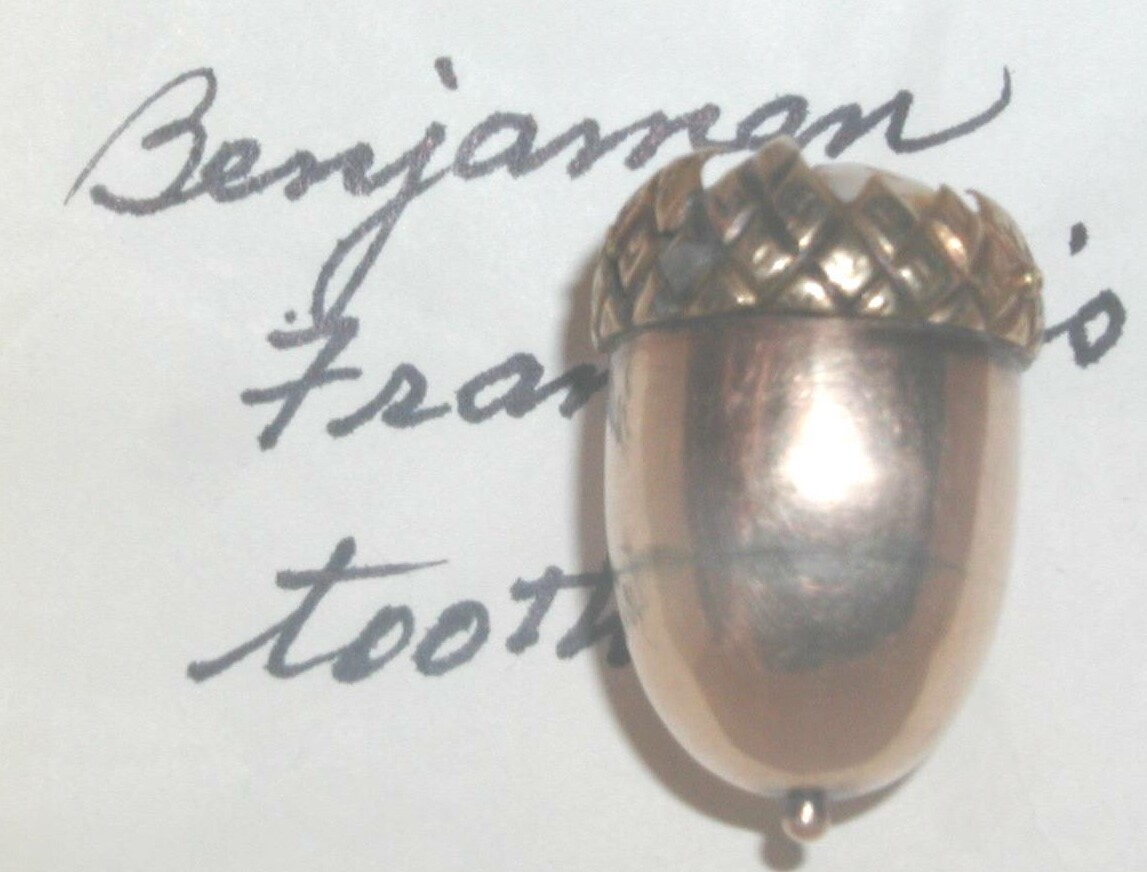 Note the slotted-head bolt or riveton the top right and the possible solder joint at the top left 90 degrees from the rivet/bolt. There is another possible solder joint on the opposite side of the tooth. Note the black circle around the acorn slightly over half way down from the rim's edge. The handwriting behind the tooth was with the tooth in a bag. |
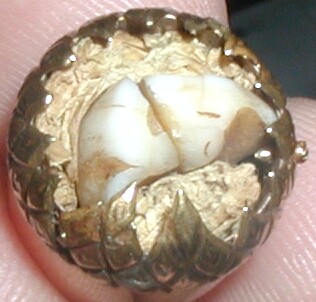 Note the possible solder joint at the bottom left 90 degrees from the rivet/bolt, the paper packing on the sides of the tooth and the crack across the middle of the tooth. There is a another solder joint barely showing on the opposite side of the acorn rim. Note the top edge of the acorn body showing at various places in between the rim's spikes. Here is a complete view of the note that was in the bag with the tooth: |
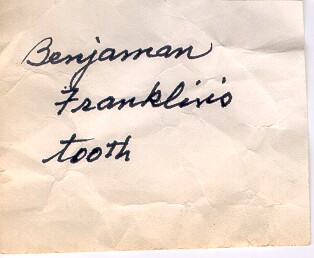 Here are scanned images of the acorn: |
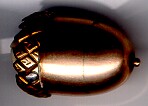 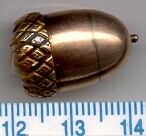 The scale is in centimeters (12 to 14 on the scale). So it is about 22 mm from the top of the crown to the end of the tip. |
| Pictures taken by John Kline of Gentry Studio, Blacksburg Virginia: |
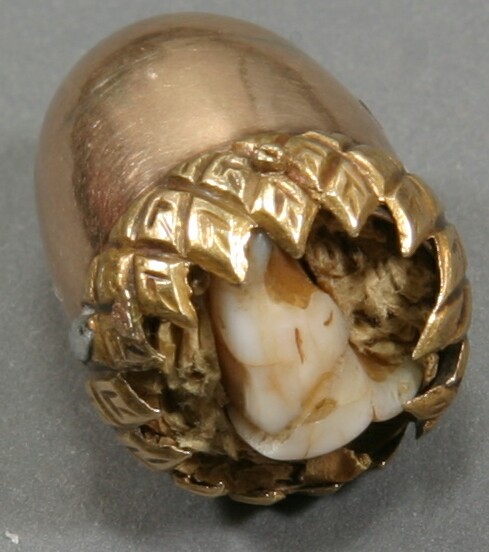 |
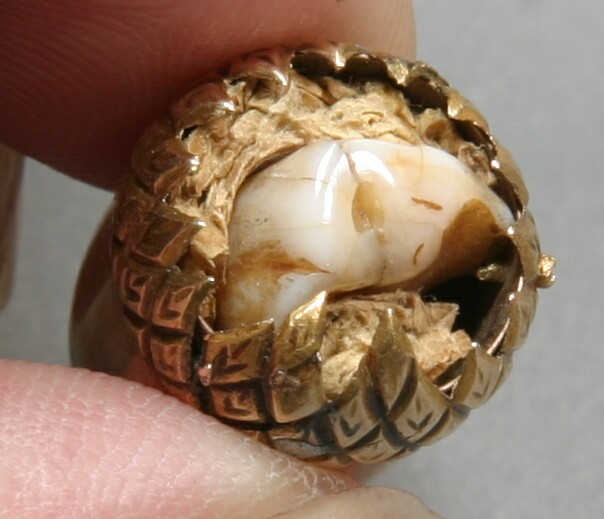 The inside portion of the rivet/bolt is visible in this view. |
| Picture after the tooth was removed, the roots were removed and the tooth war restored in the acorn: |
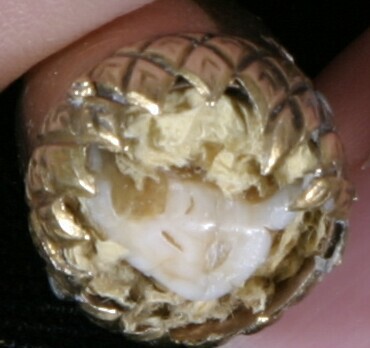 |
Dimensions of the tooth-acorn:
|
I think that the two solder joints are where a watch-fob chain was attached, so that the tooth would hang with the crown up when it was worn as a watch fob. The solder joints may have broken in the past, allowing the tooth to fall and crack it and perhap chip a side off of it.
For more details about the tooth-acorn, see http://www.roperld.com/franklinbentooth.htm.
Some possible future work about Benjamin Franklin's DNA:
We know from his writings (http://www.historycarper.com/resources/twobf3/letter7.htm and http://www.historycarper.com/resources/twobf3/letter2.htm and http://www.uky.edu/KGS/education/bigbonelick.html) that Benjamin Franklin was interested in fossil teeth of animals.
He wrote of the role of teeth in the phonetic alphabet: http://www.historycarper.com/resources/twobf3/phonetic.htm.
His son Willliam Franklin, Governor of New Jersey, lost his teeth while in prison for being a Tory: http://www.umkc.edu/imc/franklin.htm
Quotes of Benjamin Franklin about teeth:
Some references about extracting DNA from animal teeth: